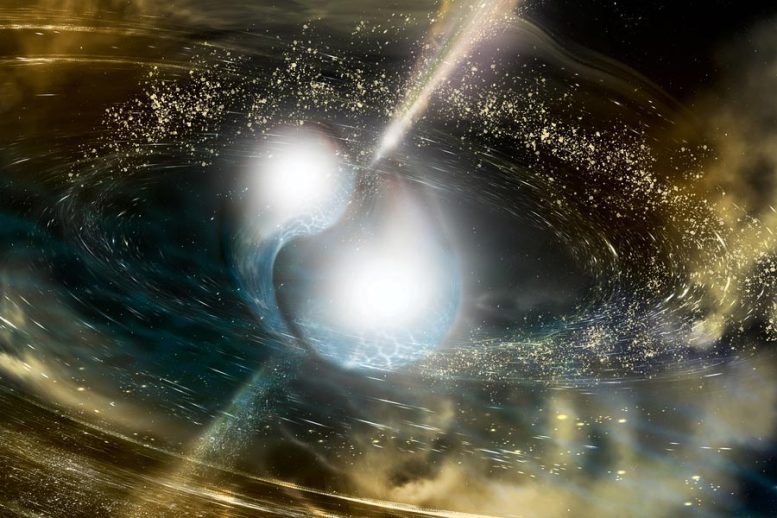
New research suggests binary neutron stars are a likely cosmic source for the gold, platinum, and other heavy metals we see today. Credit: National Science Foundation/LIGO/Sonoma State University/A. Simonnet, edited by MIT News
Mergers between two neutron stars have produced more heavy elements in the last 2.5 billion years than mergers between neutron stars and black holes.
Most elements lighter than iron are forged in the cores of stars. A star’s white-hot center fuels the fusion of protons, squeezing them together to build progressively heavier elements. But beyond iron, scientists have puzzled over what could give rise to gold, platinum, and the rest of the universe’s heavy elements, whose formation requires more energy than a star can muster.
A new study by researchers at MIT and the University of New Hampshire finds that of two long-suspected sources of heavy metals, one is more of a goldmine than the other.
The study, published today (October 25, 2021) in Astrophysical Journal Letters, reports that in the last 2.5 billion years, more heavy metals were produced in binary neutron star mergers, or collisions between two neutron stars, than in mergers between a neutron star and a black hole.
The study is the first to compare the two merger types in terms of their heavy metal output, and suggests that binary neutron stars are a likely cosmic source for the gold, platinum, and other heavy metals we see today. The findings could also help scientists determine the rate at which heavy metals are produced across the universe.
“What we find exciting about our result is that to some level of confidence we can say binary neutron stars are probably more of a goldmine than neutron star-black hole mergers,” says lead author Hsin-Yu Chen, a postdoc in MIT’s Kavli Institute for Astrophysics and Space Research.
Chen’s co-authors are Salvatore Vitale, assistant professor of physics at MIT, and Francois Foucart of UNH.
An efficient flash
As stars undergo nuclear fusion, they require energy to fuse protons to form heavier elements. Stars are efficient in churning out lighter elements, from hydrogen to iron. Fusing more than the 26 protons in iron, however, becomes energetically inefficient.
“If you want to go past iron and build heavier elements like gold and platinum, you need some other way to throw protons together,” Vitale says.
Scientists have suspected supernovae might be an answer. When a massive star collapses in a supernova, the iron at its center could conceivably combine with lighter elements in the extreme fallout to generate heavier elements.
In 2017, however, a promising candidate was confirmed, in the form of a binary neutron star merger, detected for the first time by LIGO and Virgo, the gravitational-wave observatories in the United States and in Italy, respectively. The detectors picked up gravitational waves, or ripples through space-time, that originated 130 million light years from Earth, from a collision between two neutron stars — collapsed cores of massive stars, that are packed with neutrons and are among the densest objects in the universe.
The cosmic merger emitted a flash of light, which contained signatures of heavy metals.
“The magnitude of gold produced in the merger was equivalent to several times the mass of the Earth,” Chen says. “That entirely changed the picture. The math showed that binary neutron stars were a more efficient way to create heavy elements, compared to supernovae.”
A binary goldmine
Chen and her colleagues wondered: How might neutron star mergers compare to collisions between a neutron star and a black hole? This is another merger type that has been detected by LIGO and Virgo and could potentially be a heavy metal factory. Under certain conditions, scientists suspect, a black hole could disrupt a neutron star such that it would spark and spew heavy metals before the black hole completely swallowed the star.
The team set out to determine the amount of gold and other heavy metals each type of merger could typically produce. For their analysis, they focused on LIGO and Virgo’s detections to date of two binary neutron star mergers and two neutron star–black hole mergers.
The researchers first estimated the mass of each object in each merger, as well as the rotational speed of each black hole, reasoning that if a black hole is too massive or slow, it would swallow a neutron star before it had a chance to produce heavy elements. They also determined each neutron star’s resistance to being disrupted. The more resistant a star, the less likely it is to churn out heavy elements. They also estimated how often one merger occurs compared to the other, based on observations by LIGO, Virgo, and other observatories.
Finally, the team used numerical simulations developed by Foucart, to calculate the average amount of gold and other heavy metals each merger would produce, given varying combinations of the objects’ mass, rotation, degree of disruption, and rate of occurrence.
On average, the researchers found that binary neutron star mergers could generate two to 100 times more heavy metals than mergers between neutron stars and black holes. The four mergers on which they based their analysis are estimated to have occurred within the last 2.5 billion years. They conclude then, that during this period, at least, more heavy elements were produced by binary neutron star mergers than by collisions between neutron stars and black holes.
The scales could tip in favor of neutron star-black hole mergers if the black holes had high spins, and low masses. However, scientists have not yet observed these kinds of black holes in the two mergers detected to date.
Chen and her colleagues hope that, as LIGO and Virgo resume observations next year, more detections will improve the team’s estimates for the rate at which each merger produces heavy elements. These rates, in turn, may help scientists determine the age of distant galaxies, based on the abundance of their various elements.
“You can use heavy metals the same way we use carbon to date dinosaur remains,” Vitale says. “Because all these phenomena have different intrinsic rates and yields of heavy elements, that will affect how you attach a time stamp to a galaxy. So, this kind of study can improve those analyses.”
Reference: “The Relative Contribution to Heavy Metals Production from Binary Neutron Star Mergers and Neutron Star–Black Hole Mergers” by Hsin-Yu Chen, Salvatore Vitale and Francois Foucart, 25 October 2021, The Astrophysical Journal Letters.
DOI: 10.3847/2041-8213/ac26c6
This research was funded, in part, by NASA, the National Science Foundation, and the LIGO Laboratory.









a gold stamp seal of approval
the quality of that golden galaxy
is it 24 carat
is it 18 carat
a heavy metal quality control
but does it give us all 120 elements
Occam’s Razor
“entities should not be multiplied beyond necessity”
Our planet created all the elements by itself as it evolved from a mass of quark plasma to what it is today. Quark plasma consists of separated quarks with the catalyst being the density of the electron neutrinos of space. Black holes are made of quark plasma. Quark plasma first fuses the quarks and electron neutrinos to create neutrons on the surface turning the mass into a neutron star and giving the mass its first light. The neutrons decay to hydrogen and then the constantly forming neutrons fuse with the hydrogen to form the first helium atoms through the beta minus decay reaction. This reaction continues to form heavier elements using the energy of the quark plasma underneath the surface. The star gets darker as the surface is covered by elements. Eventually, the star goes dark and a surface forms. This allows an atmosphere to develop because the surface is now protected by the energy underneath the surface. Our planet began its life as a quark star because the big bang created all the galaxies from a collision that created quark plasma shrapnel. Nothing was ever created as gas and dust. This is how Occam’s Razor is applied to the Lambda-CDM model.
Everything is correct, but with some clarifications:
stable matter of the universe goes through 4 stages of synthesis.
strings – quarks – nucleons – atoms. And creates 4 types of gravity.
https://www.youtube.com/watch?v=tFUM3vAlaGc
You will be famous when you publish.
I posted the most modern way – a video on You Tube. There is a translation. Do you think they will not give an award for this?
And Swiss scientists told me: It doesn’t matter where he published – it matters WHAT.
Obviously it matters where science is published, as it needs to go through peer review, and equally obvious you will not get what you want (“awards”).
How did the elements cross the universe to get to here? I leave an perfectly legitimate, law-abiding explanation and it gets erased. Why? How many years will this confusion go on? It is ridiculous.
Since you don’t post science, only troll science sites with nonsense, your comments are treated thusly.
What did you think!?
Mike might be right. Neutron+Neutron = equals more…Black holes-neutron= all gone. Or big bang, filled up,explode,vaporize
“Big bang” was not an explosion – this makes no more sense than Pollock comments do.
Mike Pollock there is a great deal of experimental, theoretical, and computer modeling work that has gone into proving that the big bang would produce mostly hydrogen, helium, and a small amount of lithium. Quark gluon plasma will condense preferably into the lowest mass quarks and their simplest composites, the lightest elements. There was no time for the expanding universe to create the heavier elements.
You come here to a forum where few if any will understand these theories or how it is that we know the evolution of the early universe to the extent we do. You should be trying to put your pet theory to scientists but I suspect you have already been rejected for publication because you do not have a full fledge theory with calculation to prove the thesis. You won’t convince anyone worth convincing in a facebook forum.
Pollock doesn’t know what publication is, nor the rest of science, as seen from his comments.
Mick pollock you are a very clever person. Thanks for your explanation it makes sense to me. Keep up the good work and explanations
He is not “clever” – he is the worst case of Dunning-Kruger incompetence in a long while.
Thank you Cynthia and Andrew. I’m not used to hearing compliments. I will follow by saying this. A black hole must be able to represent its kinetic energy in the future as potential energy. With supernovae, there is no clear path for the conservation of mass and energy to work. Black holes are simply the most energy matter can possess. Our moon has transformed its plasma energy into a round rock. That is why everything is round because it all started out in the plasma state. If you look up “Mike Pollock gravity” on Google, you will find my Quora site where I am closing in on 600K views. I believe you will find it very entertaining.
Thanks for the address. I read both your theory and the theories of commentators. Everything is wrong. My theory is the best – it gives all the answers to all the questions about the universe. There was no big explosion – there was and continues the Great Synthesis. Gravitational waves do not exist Gravity is the reactive thrust of ordinary electromagnetic waves. There are 4 types of gravity:
1) the gravity of the strings is 10 ^ 28 times stronger than the gravity of atoms, it collected all the strings from the primary vacuum in the center of the universe with a diameter of 2 * 10 ^ 28 light years and started the synthesis of quarks for the centers of galaxies .;
2) the gravity of quarks is 10 ^ 18 times stronger than the gravity of atoms. It keeps all galaxies in orbits around the Center of the Universe;
3) the gravity of nucleons is 10 ^ 6 times stronger than the gravity of atoms
It holds all the stars in orbits around the centers of galaxies;
4) the gravity of atoms keeps all the planets, comets and asteroids in orbits around the stars, satellites around the planets and people pressed to the ground.
https://www.youtube.com/watch?v=tFUM3vAlaGc